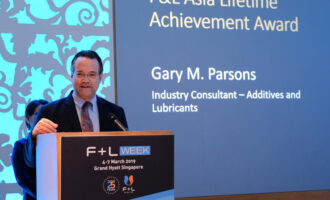Should older API engine oil categories be on the chopping block?
If you love your vehicle, no doubt you understand the importance of protecting its engine with the highest possible quality oil. Perhaps you’re even aware of the multitude of industry specifications that guide engine oil development, or the American Petroleum Institute (API) Service Symbol ‘Donut’ and “Starburst” Certification Marks used for products meeting API motor oil standards.
There is an abundance of light and heavy-duty engine oil standards. Many have been active in the marketplace for a considerable length of time. Some standards continue to enjoy widespread use and remain relevant for modern day engines, others are perhaps less so. But when do we con- sider a specification no longer necessary, adding further complication to licensing without providing considerable value? At what point should older specifications be declared obsolete?
CH-4 is the oldest heavy-duty category maintained by API, first licensed two decades ago in 1998. While there are rumours of in-market oils claiming earlier categories such as CG — API no longer licenses these classes. Even CH-4 has long since been surpassed — initially by the introduction of CI-4 in 2002, which allowed high-speed, four- stroke engines to meet 2004 exhaust emission standards and provided for changes in sulphur content in diesel fuels.
Most recently, API CK-4 compliant oils exceed the performance criteria of API CJ-4, CI-4 with CI-4 PLUS, CI-4, and CH-4. The CK-4 category provides for 2017 model year on-highway and Tier 4 non-road exhaust emission standards and is formulated for diesel fuels with sulphur content up to 500 parts per million (ppm). However, the use of these oils with greater than 15ppm sulfur fuel may impact exhaust aftertreatment system durability and/or oil drain interval.
With so many more recent engine oil categories, why is CH-4 still necessary? Shouldn’t it already be on the chopping block?

Diesel Engine Oil Advisory Panel (DEOAP) Co-Chairman Dan Arcy claims the 20 year-old standard remains an “important specification across the industry,” though, “not really required in America.” Arcy is global OEM technical manager and industry trade association liaison at Shell Global Solutions. He says the standard is important in developing regions that still have fuels with high levels of sulphur, such as Africa and parts of South America. Roger Gault, vice president for regulatory activities of the Truck and Engine Manufacturers Association (EMA), supports Arcy’s contention, suggesting it is not uncommon to witness 30-year-old engines in use on the road, or off road such as at construction and mining sites.
The DEOAP is a formally constituted committee composed of representatives from API and EMA member companies with a specific focus on heavy-duty lubricant matters. The DEOAP facilitates the introduction, maintenance and withdrawal of heavy-duty performance categories.
Maintaining an engine oil category is no easy feat. Historically, standards have been guided by the availability of engine parts to run the tests. Gault says earlier categories CG and CF vanished primarily due to the non-availability of engine parts for the required test methods. This remains the biggest issue in the longevity of all the current categories.
However, Arcy indicates there are several changes underway in this space. On the passenger vehicle side, for example, the parts for the Sequence IIIF test will be gone some- time next year, prompting a recommendation to replace it. The substitute Sequence IIIH test will apply new limits to qualify against the older test. We are seeing the same approach on the heavy-duty side, contends Arcy. The surveillance panel for the engine oil aeration test is drafting a recommendation for replacing the old engine oil aeration test using the new test adopted in the CK-4/FA-4 categories.
But is it worth just biting the bullet and removing categories for the sake of simplicity? The first question that springs to mind is how many oils are actually licensed under each category? Kevin Ferrick, senior manager of API’s Engine Oil Licensing and Certification System (EO- LCS), says CJ-4 — which was designed to meet the 2017 15 ppm maximum fuel sulphur, as well as enhanced wear protection, 1.0% ash maximum, US EPA 07 ||— has more than 1,600 licensees. Does this make it the most popular category? The truth is… no statistics are kept on this. Oil manufacturers pay a minimum application or annual renewal fee to API and a volume of sale fee for API-licensed oils sold, not a per product fee.
As for the older CH-4 engine oils — who knows? It seems we are missing the requisite clarity around usage volume to inform decisions on category removal. Arcy says the issue of obsolete categories is “something I have on the agenda every time, so I don’t forget,” referring to the every six- months DEOAP meetings. Withdrawals are typically requested by engine manufacturers, and API reviews the need to declare a category obsolete.
However, requests can get a little tricky, says Arcy. Particularly as not all newer specifications are backwards compatible. For example, API FA-4 is only partially backwards compatible — for some engine manufacturers back to 2010 production year. Although he confirms that CK-4 is backwards compatible across the board.

According to Gault, there have been no current categories brought forward for removal, nor does he forecast any new performance standard requirements at this point. Typically, a request for a new category is made by a sponsor based on hardware, operating conditions, or emission standards changes.
Does this mean we have reached the end of the line with emissions? Arcy doesn’t believe so. New legislation has been proposed for phase 2 greenhouse gas emissions in North America, which could lead to a change in oil requirements, though the details are unknown at this time.
The establishment of a new category is currently a three-phase process. OEMs typically highlight their requirements at the earliest opportunity, at which point the new category evaluation team reviews the appropriateness of a new category. The subsequent new category development process includes the creation of the new category and the establishment of the required tests. The final phase is implementation, which incorporates voting, naming and mandatory time frames for manufacturers to qualify their oils and get them into the marketplace.
However, the category development process is currently under review as the organization looks for greater efficiencies. The Lubricant Standards Development Review Group has been tasked with reviewing and improving the existing process and, while this has been attempted before, Arcy says this is probably the organization’s most aggressive attempt at it.
The Lubricant Standards Development Review Group includes representatives from EMA, The Alliance of Automobile Manufacturers, American Chemistry Council (ACC), base oil manufacturers, and oil marketers, who meet once a month. The group is currently in the process of reviewing pros and cons of the current process — before looking to prioritize potential changes. Arcy says the charter is likely to be complete in 18 months, about the same time as ILSAC GF-6’s first licensing date.







